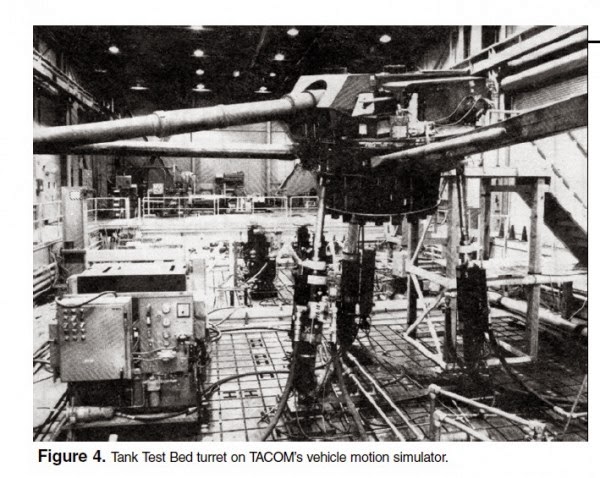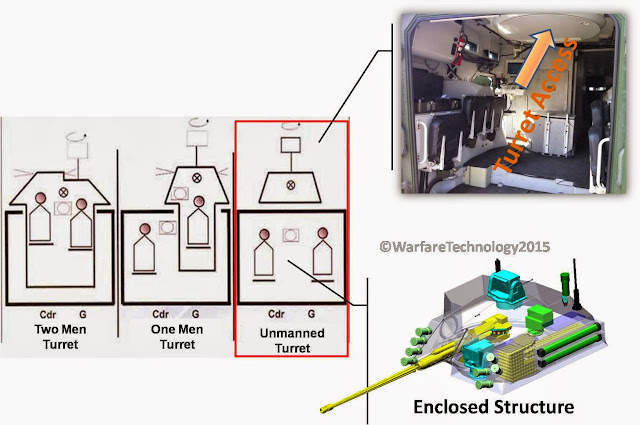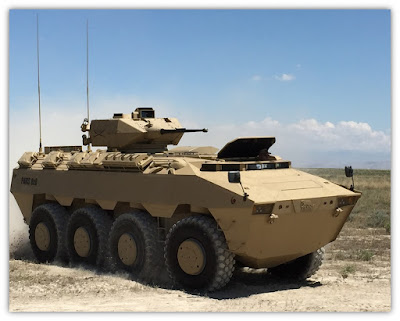↧
Cockerill 3000 Series Turret Revealed
↧
Oerlikon's Turreted Laser Gun
↧
↧
T40 Two Men Turret from Nexter
Nexter is exhibiting their T40 Two Men Turret on VBCI 8x8. The turret is armed with a CTA 40mm autocannon.
VBCI 8x8 with this turret has undergone mobility and fire testing in Qatar for the Qatari Army last year.
↧
Solutions for Every Army
In IDEX, there are soutions in many different complexity levels for everyone.
A good example for contrast is the mortar systems.
Here is the Sudanese Vehicle Mounted Mortar:
↧
IDEF 2015
↧
↧
FNSS's Brand New IFV - Kaplan
↧
FNSS's Next Ace: Pars 4x4
↧
IDEF'15: BMC VURAN 4x4
↧
IDEF'15: Nurol's 4x4: Ejder Yalcin
↧
↧
M1 Tank Test Bed (TTB) with Unmanned Turret
M1 Abrams Tank Test Bed
A Long Time Ago, In a Galaxy Far, Far Away...
Long Before Armata MBT, There was M1 TTB...
In the mid-80s, US Tank Automotive Command (TACOM) awarded a contract to design and develop a Test Bed for an M1 Abrams with an Unmanned 120mm Turret with the crew in the hull to General Dynamics Land Systems.
 |
| M1 Tank Test Bed (TTB) with Unmanned Turret |
The distinctive feature of this Test Bed is the Unmanned Turret with the Autoloader.
 | |
|
The crew including the Tank Commander, Gunner and Driver are located in the hull. They are provided with a space ship style seating arrangement.
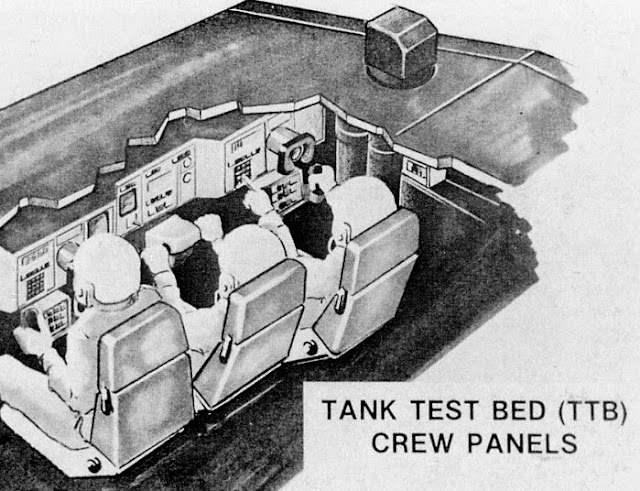 |
| TTB Crew Layout |
The tank retained the original M256 smooth bore gun albeit in an unmanned turret with the 120-mm “brassboard” autoloader transfer mechanism. This device was required to cycle ammunition from a designated storage position to a simulated gun breech and back, at 12 rounds/minute, while leaving no witness marks on the fragile combustible case after the completion of 20 loading repetitions per round.
The TTB Autoloader was a conspicuous success. The system consisted of a 44-round capacity “carousel” type mechanized magazine, located in an unmanned turret basket; a fully articulated Transfer Unit (including a rammer) positioned at the rear of the M256 120-mm cannon in the turret bustle; and a microprocessor-based, Electronic
Control Unit (ECU).
 |
| TTB Turret with AutoLoader |
 |
| AutoLoader Transfer Unit |
The system was electrohydraulically powered to utilize the existing turret power supply.
And the TTB vehicle today....
 |
TTB Vehicle Today |
Sources:
- Sharoni, A., H., Bacon, L., D., "Ammunition Loading Systems for Future Tanks", Armor, March-April, 1995
- http://infoglaz.ru/?p=47169
- http://btvt.narod.ru/3/blok3/blok3.htm
↧
On Manned vs Unmanned Turrets
On
Manned vs Unmanned
Turrets....
I've been reading on some articles recently on turrets, mainly the issue of Manned vs Unmanned (Remote) turrets.
I think two recent events have an impact on the heated discussions, these being:
- The US Army's intention of upgunning the 2nd ACR Stryker 8x8 vehicles with a weapon system having higher lethality and effectiveness than the current .50cal RWS.
- The turrets required for the Australian Land Forces' 8x8 Combat Reconnaissance Vehicle (CRV) component of the Australian Land 400 programme.
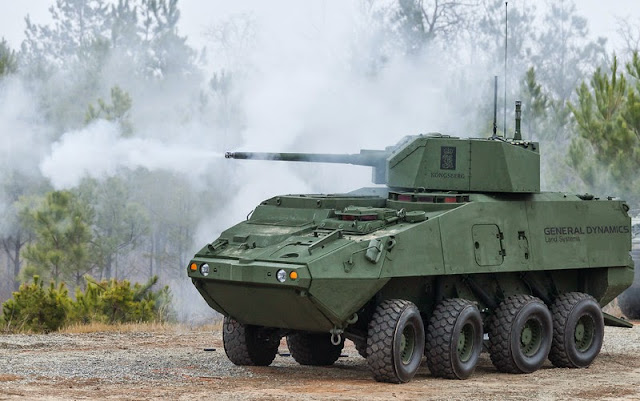 |
| Kongsberg's MCT30 Remote Turret during demonstrations at Fort Benning, February 2014 |
Citing from one of my previous posts on Remote Turrets:
- Remote turrets are enclosed structures with all the subsystems like the ammunition feed chutes, ammo boxes and drives are inside an armored cocoon. On the other hand RWS have an open architecture.
- Remote Turrets offer an important advantage of reloading under armor whereas in most of the RWS's, the crew has to get outside to reload ammunition.
However remote turrets have some drawbacks based on the crew being located inside the hull. Main item being total dependency on the sensors/electro-optics.
During operations, the the commander's capability to crack open the hatch and have a look around the vicinity provides a big advantage in terms of situational awereness.
During operations, the the commander's capability to crack open the hatch and have a look around the vicinity provides a big advantage in terms of situational awereness.
In addition, the sighting systems in the remote turrets, cannot include direct view optics, which is also avery important for some armies such as British Army.
Another issue for the remote turrets is the difficulty of the gunner losing the feeling on the turret/barrel orientation. The gunner is located inside the hull and his sensory feedback only feels the vehicle accelerations; thus after a short while it is not uncommon for the gunner to start having difficulties on where the turret is oriented with respect to the vehicle, especially when the stabilization is turned on.
This can be overcome by utilizing easy to understand indications on the gunner's display; however still requires careful design.
One of the good articles I was reading was from the Australian Defence Technology by Ian Bostock with the title of "Pointers hint at unmanned future for CRV turret".
One of the points in the article states that Remote Turrets offer significant weight savings (the article says 1.200 to 2.000kg's) compared with a manned turret with equivalent protection levels.
I have to disagree with this statement.
Suppose you are converting a two-men turret to a remote turret keeping the protection level the same ie. STANAG 4569 Level IV. The structural elements and equipment you can totally eliminate in a remote turret are:
One of the points in the article states that Remote Turrets offer significant weight savings (the article says 1.200 to 2.000kg's) compared with a manned turret with equivalent protection levels.
I have to disagree with this statement.
Suppose you are converting a two-men turret to a remote turret keeping the protection level the same ie. STANAG 4569 Level IV. The structural elements and equipment you can totally eliminate in a remote turret are:
- Hatch mechanisms (hinges, locks, handles, etc.)
- Periscopes
- Spall liners (if present on the 2 men turret)
- Basket structure
- Seats
On the other hand, you still have to put two seats inside the vehicle for the commander and gunner. Also the displays, handles, structural elements for these still have to be located inside the vehicle. So these are weight-wise not totally eliminated albeit some reduction in the volume invaded compared with the basket swept volume for a manned turret.
However, the ammunition boxes for the main gun and the coax gun that were generally in the basket for the two-men turret have to be relocated to the turret hull. The former 2 men turret hull did not include these, so it usually means you have to increase the turret hull size to accommodate the ammo boxes. The following images shows the ammobox size for a 30mm turret with linked and linkless ammunition types. These ammo boxes takes up considerable volume inside the turret hull for a remote turret.
 | |||
| The AmmoBox for 30mm Turret (GD Mk46) |
 |
| Linkless Ammunition Feed System with Two 75 Round Ammo Boxes on Each Side of 30mm Cannon |
As size means more surface area and more surface area means weight, you dont get to save that much weight by converting to a remote turret.
 |
| AmmoBox inside the hull for a remote turret |
Also, for the remote turrets, the turret cutout on the vehicle roof has to be covered by a hatch. This also adds weight.
The result shows, you usually dont save significant amount of weight with a remote turret having the same protection level as a two men turret.
However, the trick is reducing the protection level for the remote turret considering the fact that there is no crew inside. This approach would pave the way for weight reduction.
So, in my opinion, the remote turrets although offer some advantages are not the perfect solution to replace all the other turrets.
The correct answer probably lies in the configuration and mission of the vehicle, such as:
- If the vehicle is a pure IFV that is going to go head to head with the enemy vehicles, two men turrets offering more situational awereness and control over the battlefield would have a definite advantage.
- If the vehicle is a reconnaissance vehicle that is to be used for recon-with-fire principle, again the two-men turrets offer more advantages for situational awereness.
- For a reconnaisance platform relying more on electro-optics and sensors, you will need more room inside the vehicle for operators, more displays, consoles, etc. Remote turrets should be preferred.
- For a command platform, again you need more room inside for command consoles, communication equipment, etc. Remote turrets would be a better solution.
↧
While we are on Remote Turrets, Enter Epoch...
Russia's Entry in the Remote Turrets Arena:
Epoch 30mm
 |
| Epoch 30mm Remote Turret |
Since the May 9th parade in Moscow, the new Russian Armored Vehicles and Armata MBT have been quite a hot topic.
 |
| Epoch 30mm Remote Turret |
On the new T-15 Heavy IFV, Kurganets-25 IFV and Boomerang 8x8, there was one big commonality and that was the Epoch Remote Turret.
 |
| Epoch Turret on T15 Heavy IFV |
Epoch Turret is developed by the KBP Design Bureau in Tula, Russia.
The turret is remotely operated from inside the vehicle and armed with a 2A42 gas operated, dual-feed 30mm autocannon and a coaxial 7.62mm PKT Machine Gun.
The 2A42 cannon has a maximum rate of fire of 800 and a muzzle velocity of 960 m/s.
The turret also has two Kornet-EM ATGM missiles on each side.
Kornet-EM is the most modern version of the Kornet missile system with three different warheads, a tandem HEAT warhead for tanks, a thermobaric warhead and a HE warhead. The most important capability is the automatic target tracker in the system that eliminates the gunner having to track the target until the missile impact. The range is also increased to 8-10km's.
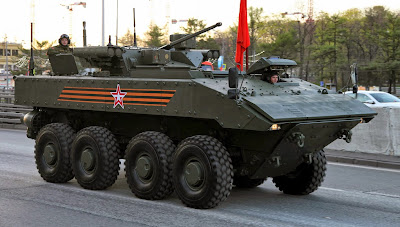 |
| Epoch Turret on Boomerang 8x8 IFV |
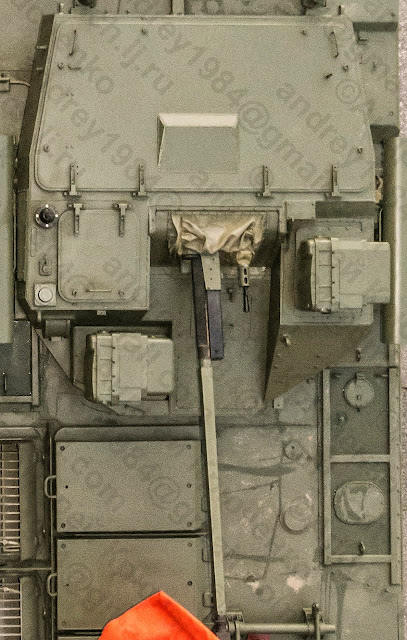 |
| Epoch Turret Top View |
The ammunition for the main and coaxial guns are stored in bustle located ammoboxes. The 2A42 gun has a impressive load of 500 ready rounds with 340 of these being of the HE type and the remaining 160 being of AP type.
As you can see from the image above, the large hatch at the back of the turret is most probably for the reloading of ammunition. It leads me to think that there is probably no reloading from under armor for this turret.
The coax 7.62mm gun has 2.000 ready rounds which is also quite a feat.
The turret has all electric drives and has 2 axis stabilization capability.
The internal layout of the turret is shown below:
 |
| Epoch Turret Layout |
The turret has got two identical looking stabilized sights for the gunner and commander. A computerized fire control system is fitted with thermal imagers, day cameras and laser range finders for increased first round hit probability. All around the turret, laser warning receivers and smoke grenade launchers are located.
We will see if this new turret will be the universal turret for the new toys of the Russian Army.
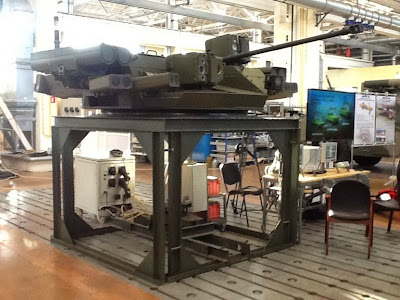 | |||||||
| Epoch Turret on Stand |
 | ||
| Rear Side of the Turret |
↧
Third Round in US Army's IFV Replacement
FUTURE FIGHTING VEHICLE
Third round has started in US Army's ill-fated Bradley Replacement Efforts
It was FCS - Future Combat Systems first in 2002 that aims to replace M2 Bradley with a new vehicle, namely: XM1206 ICV.
 |
| XM1206 ICV |
The FCS was cancelled in 2009 and XM1206 went with it.
Then in 2009, Ground Combat Vehicle, GCV - a program aiming for the replacement of Bradley starts in 2009.
 |
| BAE Systems GCV Concept |
GCV aimed at developing an Infantry Fighting Vehicle with a high degree of protection using available technologies.
However, on February 2014, GCV gots terminated following its predecessor.
Fast forward to June 2015, enter Future Fighting Vehicle via Defense News:
From the ashes of the US Army's canceled 70-ton ground combat vehicle, the Future Fighting Vehicle (FFV) program has begun to sprout — at least concepts for it.
The Army has awarded two contracts of more than $28 million each to BAE Systems Land and Armaments and General Dynamics Land Systems to develop design concepts for the FFV. The work is due Nov. 28, 2016.
The effort is meant to inform whether the Army will produce an entirely new vehicle or a potential replacement for the BAE-manufactured Bradley fighting vehicle, (which I didnt understand or lead to a third round of improvements for the Bradley.
The companies are to conduct trade studies, requirements analysis, and modeling and simulation, and assess technology capability and maturity to support each of three design concepts...
We will all see if really the third time is the charm...
↧
↧
Blast from the Past: VZ9 AvroCar
Blast from the Past:
VZ9 AvroCar
In 1952, a design team headed by J.C.M. “Jack” Frost, of Avro Aircraft, Canada, began design work on a supersonic VTOL aircraft with a circular wing. The Canadian Defense Research Board funded the effort with a $400,000 contract.
VTOL capability was to be achieved by ducting fan air and engine exhaust to the periphery of the planform and deflecting the air flow downwards. Close to the ground, this provides a cushion effect where the lift exceeds the thrust due to increased pressure on the underside of the aircraft.
VTOL capability was to be achieved by ducting fan air and engine exhaust to the periphery of the planform and deflecting the air flow downwards. Close to the ground, this provides a cushion effect where the lift exceeds the thrust due to increased pressure on the underside of the aircraft.
This phenomenon was confirmed in a wind tunnel test. For transition to forward flight, the air flow would be gradually redistributed backwards. Frost was convinced that a thin, circular planform wing, or flying saucer, was the ideal shape to take advantage of both the ground cushion effect (for STOL overload capability) and supersonic flight.
Originally designed as a fighter-like aircraft capable of very high speeds and altitudes, the project was repeatedly scaled back over time and the U.S. Air Force eventually abandoned it.
Development was then taken up by the U.S. Army for a tactical combat aircraft requirement, a sort of high-performance helicopter.
Development was then taken up by the U.S. Army for a tactical combat aircraft requirement, a sort of high-performance helicopter.
 |
| VZ9 AvroCar Cutaway |
 |
| AvroCar with Canopies Open Showing Cockpit Interior |
On June 9, 1961, the second and final USAF flight evaluation of the Avrocar was conducted at the Avro facility. During these tests, the vehicle reached a maximum speed of 20 Kts and showed the ability to traverse a ditch six feet across and 18 inches deep. Flight above the critical height was impossible. The flight test report summarized a litany of control problems.
Avro proposed radical modifications to the vehicle to address the major problems. Frost’s team developed two new designs, one with a large vertical tail and one with a wing with tip mounted verticals. Both designs used two 2700 lb thrust GE J-85 turbojets in lieu of the three 920 lb thrust J-69’s and increased the turborotor diameter from five to six feet.
The proposals were rejected, and the program was terminated in December 1961.
Sources:
- Lindenbaum, L., Blake, W., "The VZ-9 “AVROCAR””
↧
Stryker Upgunning - Send in Bradleys
On the Upgunning of Strykers
Why is it urgent?
It's been circulating around quite a lot these days on the potential Upgunning of the Styrker 8x8 wheeled armored vehicles with a more lethal weapon system than the .50cal Remote Weapon Stations.
With the 2nd Armored Cavalry Regiment's Europe Tour fueled with Russia's apparent aggressive policy towards Ukraine and Baltic States, this became a something like a desperate cry.
 |
| Stryker being tested with Kongsberg MCT30 30mm Remote Turret |
However, Breaking Defense website has a different take on this based on their latest news article.
"Certainly, General Dynamics would like to upgun a much larger portion of the Stryker fleet, with the European vehicles as the leading wedge, and two key committees on the Hill have voted sums in the $371 million to $411 million range, which would surely buy more than 81 upgrades. (The first committee to vote on the matter added a relatively modest $80 million).
There’s also the critical wrinkle that the request from the 2nd Cav came as an Operational Needs Statement (ONS), but not an Urgent Operational Needs Statement (UONS)."
However, the question to be asked is:
Why not send M2 Bradleys??
Thanks Tony...
 |
| Bradley's Latest Version M2A3 BUSK |
↧
SABER, One Man Turret
SABER
MEDIUM CALIBER
ONE-MAN TURRET
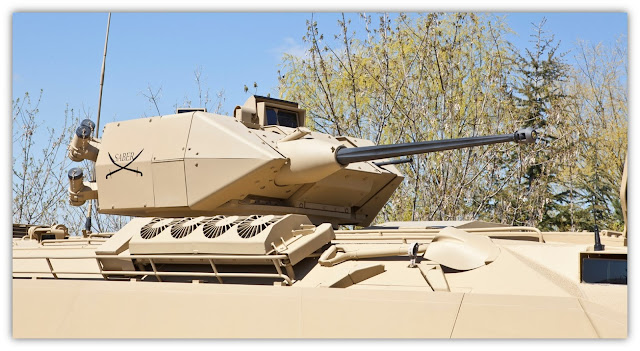 |
| FNSS SABER One Man Turret, 25mm |
FNSS of Turkey has recently revealed that their brand new SABER, One-Man Turret has successfully completed firing qualifications.
Development of the SABER turret started in 2013 and is privately funded. The turret was first revealed at IDEX 2015 exhibition in UAE, February 2015.
SABER is a medium caliber one man power operated turret that can be deployed on a wide range wheeled and tracked armored vehicles. SABER turret incorporates the latest technologies in turret drives, fire control, protection and lethality. The compact dimensions and light weight makes SABER a suitable choice for different types of armored vehicles.
SABER turret offers more than 60% larger internal volume than FNSS’s previous generation one man turret with less than 10% increase in outer envelope dimensions.
The main armament consists of an ATK 25mm M242 Enhanced Bushmaster 25mm dual-feed automatic cannon which is provided with 240 rounds (150+90) of ready-use ammunition.
A 7.62mm M240 machine gun is mounted coaxially with the M242 cannon on the left hand side of the turret and is provided with 600 ready use ammunition.
A bank of three 76mm grenade launchers is mounted on both sides of the turret towards the rear. These could also be replaced by grenade launchers of other calibers.
The digital fire control and sighting system includes a 3rd Generation long wave or mid wave thermal imager, a telescopic day optical channel, unity window for surveillance, an eye safe laser range finder with 8.000m range and ballistic computation capability.
The gun turret drive system is electrical and fully digital with two axis stabilization capability to ensure a high accuracy of fire on the move. The traverse and elevation drives have manual backup capability. Turret traverse is all-electric through 360 degrees, with weapon elevation from -8 to +48 degrees.
Turret shell is made of all-welded aluminum armor wth add-on composite and steel armour providing ballistic protection to STANAG 4569 Level IV standard.
↧
Russian Su-24 shotdown in Turkish Syrian Border
Su-24 Fencer
Shotdown by Turkey
at Syrian Border...
Today, at around 09:20 Turkish Local Time, an aircraft identified as Sukhoi Su-24 was reportedly shot down on Turkish-Syrian border region.
The shotdown Su-24 is reported to belong to Russian Air Force and amongst the force that was deployed to support Syrian Government Forces against the opposition in the Syrian Civil War.
Turkish Office of Chief of Staff announced that the aircraft has been warned 10 times in 5 minutes to leave Turkish airspace. After which was shot down by two Turkish F-16 fighter jets.
The shotdown of the Su-24 was recorded from ground.
(Copyright: Anadolu Ajansı www.aa.com.tr)
Turkish Office of Chief of Staff also revealed the radar trajectory of the Su-24 showing its penetration to Turkish airspace from Syria.
The Red lines reflect the tractory of the shotdown Su-24. The bright blue lines identify the Turkish airspace boundaries.
The pilots of the Su-24 was seen ejecting and parachuting down to the Syrian side of the border where heavy clashes are being reported today between pro-Syrian forces and opposition. There is no information on the status of the pilots. Russian helicopters in search pattern were seen in the area short time after the crash.
Su-24 NATO Codename: Fencer is a supersonic, two-seat, all weather attack aircraft that entered service in 1975. Fencer has variable geometry or swing wing design much like the US F-111, range of 3.000km's and a payload capacity of 8 tons.
Su-24 NATO Codename: Fencer is a supersonic, two-seat, all weather attack aircraft that entered service in 1975. Fencer has variable geometry or swing wing design much like the US F-111, range of 3.000km's and a payload capacity of 8 tons.
↧
↧
Stryker Upgunning Decided: Kongsberg is the winner!
Kongsberg MCT30 Remote Turret selected for
Stryker Upgunning
 | |
|
"General Dynamics Land Systems has notified KONGSBERG that the ’PROTECTOR’ Medium Caliber Remote Weapon Station (MCRWS) has been selected as the 30-millimeter weapon system solution for the Stryker vehicles.
One thing that I am not so fond of this turret is the way 7.62mm coaxial machine gun is mounted.
“We are very pleased that our PROTECTOR MCRWS has been selected as the solution for this Stryker brigade. The system is the result of several years of determined effort to develop a system with capabilities and performance required for these types of vehicles,” says Espen Henriksen, President of Kongsberg Protech Systems.
“This is a very important milestone for our newest innovation in this field, the Medium Caliber RWS, and we are honored to support US Army and General Dynamics Land Systems in this urgent operational requirement,” says Walter Qvam, President and CEO of KONGSBERG..."
So it seems the short term competition for the Stryker Upgunning has been decided and Kongsberg wins with the MCT30 Remote Turret. As far as I know OTO Melara was also in the competition with their HitFist OWS 30mm Remote Turret and probably CMI with their CPWS Remote Turret.
The Upgrade program aims at upgunning the Strykers of the Germany based 2nd Armored Cavalry Regiment (2ACR) with a more potent/lethal weapon system than the .50cal Remote Weapon Station already integrated on the Strykers. This move leads me to thinking that the Europe based 2nd ACR needs more lethality in preparation to threat scenarios including Russian Forces.
I assume that MCT30 turret is to be armed with the brand new Orbital ATK XM813 30mm with a Linkless Ammunition Feed System from Meggitt with 150 ready rounds in dual ammo boxes on each side of the gun.
 |
| XM813 30mm Gun with Linkless Ammo Boxes on Each Side |
MCT30 is a Remote or Unmanned Turret with the subsystems and ammunition boxes being under armor protection.
There is access to the turret from inside the vehicle thru a hatch under the turret.
 |
| Vehicle Interior with MCT30 Turret Integrated |
One thing that I am not so fond of this turret is the way 7.62mm coaxial machine gun is mounted.
| 7.62mm Machine Gun Installation |
Warfare Technology has analyzed the Stryker Upgunning and Remote Turrets recently in these following articles:
↧
ZSSW-30 Remote Turret Part II
ZSSW-30
Remote Turret
Part II
 |
| Copyright: defense-update.com |
More than a year ago, Warfare Technology had an article on the new Polish ZSSW-30 Remote Turret by the Polish Company, Huta Stalowa Wola or HSW.
A new prototype of the turret was revealed during MSPO 2015 Exhibition. It seems the testing on the turret has already started.
 |
| Copyright: J. Sabacc / Defence24.pl |
ZSSW-30 is an unmanned / remote turret with the same ring diameter as the Oto Melara Hitfist-30 turret that is already in service in Polish Army on Rosomak 8x8s.
 |
| The second prototype of the new Polish ZSSW-30 Turret Unveiled at MSPO Exhibition (Remigiusz Wilk) |
The turret is armed with a 30mm Mk44 chaingun and a coaxial UKM-2000C 7.62mm machine gun. I was unable to see where the links for the 30mm gun are ejected from the photos available. This lead me to thinking that the links are collected inside, however I might be wrong as well.
On the right hand side of the turret, two Spike LR missiles are mounted.Spike LR is a fire and forget type missile with a imaging infrared seeker. The range is 4.000m with a penetration capability of more than 700mm RHA.
 |
| Dual Spike LR Launchers Copyright:http://www.altair.com.pl/ |
The gunner's sight is Polish PCO GOC-1 Nike dual axis stabilized sight system.
 | ||||||
Gunner's Sight: PCO GOC-1 Nike
GOC-1 Sight unit consists of a Mid Wave Thermal Imager, Day CCD Camera and a 10km range Laser Range Finder. The sight unit has -20° to +70° elevation and nx360° traverse capability. The Commander's Sight seems to be the Selex Janus Panoramic Sight system with a thermal imager, day camera and laser range finder.
I was unable to reach any weight data for this turret. Considering the unmanned configuration and the armament, my assumption would be around 2.5tons combat weight. As far as I can see The Polish Army is seeking a local alternative to the Oto Melara Hitfist 30P Two-Man Turrets that they have in inventory on Rosomak 8x8s.
However, it is not so clear to me why they are opting for an unmanned solution instead of the Two-Man HitFist Turrets. Ive been reading they had good experience with the Hitfist turrets from Polish Army's Operations in Afghanistan. But that's for the Polish Army to decide.. 5 ZSSW-30 turrets are planned to undergo qualification testing in 2016 and the possible series production to commence in 2017. |
↧
Rheinmetall's New Light Tank
Rheinmetall introduces a New
Light Tank
in Upcoming Eurosatory
It seems Rheinmetall is revealing a new light tank design in Eurosatory 2016 (Starting June 13th).
The light tank is probably to be called Lynx.
Now I am going to come up with some wild guesses...
Look at the images below that show a Marder IFV. The same colored arrows shows the similarities between a Marder and this Lynx vehicle.
So I think the Lynx might be based on a Marder hull... But it might also be my imagination..
↧




























